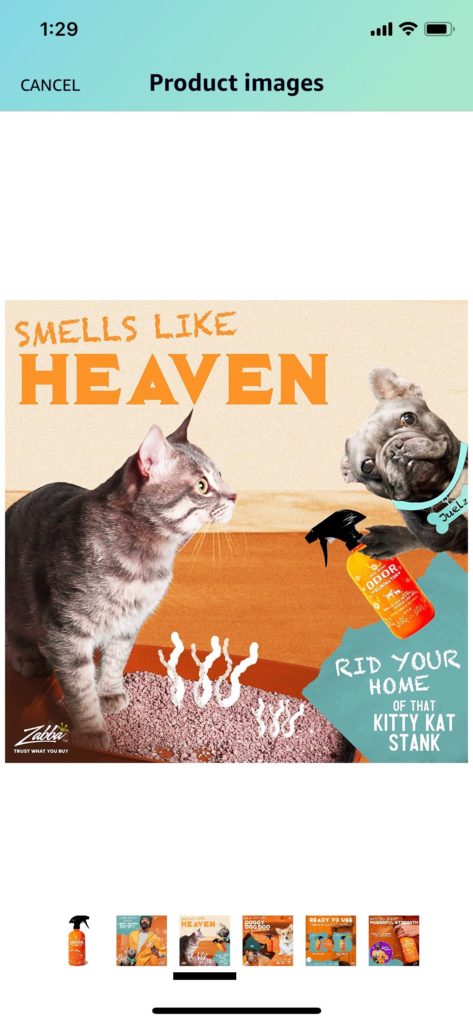How to Improve Your Product Listing on Amazon
December 18, 2020 Jenna Craig
Thrasio’s Creative Team—designers, copywriters, and project managers—work together to craft the perfect branding for each of our products. The customization of each listing elevates the quality and feel of each individual brand which builds trust with each targeted customer and increases conversion.
You don’t need to convince your customers that they need the type of product they’re looking for. In most cases, shoppers have already searched for whatever compression sleeve or pet shampoo they’re in the market for. So your challenge starts with making your listing stand a cut above the other products on the results page. In other words, you have to convince the customer that they need your brand of pet odor eliminator.
We have a team of 65 creatives that work together to make our nearly 100 brands look amazing. All the way from listings to packaging and D2C efforts. As a lot of MDS (Million-Dollar Sellers) are projecting, we’re going to see a lot more venture-backed and successful sellers dominate Amazon in the future—make sure your brands can compete.
Turn your FBA business into a brand customers trust by producing a compelling brand that converts through a complete listing, smart copy, and sharp design.
Amazon grades on completion
Amazon’s algorithm gives preferential treatment to listings that take every opportunity to add information within your seller account. This means listings that utilize all 9 listing photos, adding a video, and filling all 6 modules in A+ content.
Note, on mobile, shoppers can only see the first 6 listing photos, so make sure your strongest sales points are in those photos along with any information that needs to be clarified to a potential customer in order to avoid a poor review. The last three listing photos can show repeated information from your title and bullets, stock images, or potentially show other products within your brand.
If you have more than one product, set up your brand storefront. Not only does it give your products more exposure, but Amazon is starting to push more toward storefronts. A lot of PPC ads click through to the brand storefront rather than the specific product listing again showing shoppers more of your brand than the first product they were looking for.
Filling the gaps in your listing is not only going to elevate your product within the algorithm, it also gives you more opportunity to share the features and benefits of your products with customers.
We’ll outline how to make your listing photos, videos, A+ content, and storefront look like the million-dollar brand it is that converts.

Angry Orange Listing Photo on Mobile
Copy that
“Copy” refers to any written material on your listing. There are plenty of resources for SEO copywriting, but we’ll skip the title and bullets for now—that’s a different skill set. For the purposes of this blog post, copy refers to the words written within the photos and videos on your listing.
Whether you’re hiring a freelance copywriter or doing it yourself, think of your listings as an opportunity to tell a story. Stories are the simplest ways humans communicate with each other. Not only do stories carry an emotional impact, they’re also more memorable and digestible than a hard sell. Good copy builds a brand rather than just a listing.
With a simple product like a compression sleeve, it might be easy just to describe what material the product is made of and how to find the right size. “It’s not enough to just describe features. Your copy should speak to outcomes—both practical and emotional—that solve the problem a shopper has come looking for a solution to,” says Forrest Lee, Thrasio’s Associate Director of Copy.
The text in your photos should describe how these specific compression sleeves fit into and improve the customer’s life because they’re designed to fit perfectly, and made with superior materials. It shows the customer that the seller has time and expense to create beautiful listing photos and a sophisticated video; and therefore, the customer trusts that the same care has been taken when developing the product itself.
Pragmatically, copy describes the features and benefits of a product. It describes how a product works, and in what situations it can be used. Amazon sellers can look through their reviews and customer Q&As to address any questions or doubts posed by real customers, increasing conversion by decreasing bounce rates.
Good copy practices
Take a holistic look at your listings—including all positive and negative reviews and the Q&A. Write down the main features and benefits of your product on separate pieces of paper. Then arrange each feature/benefit in order of importance or compelling-ness. That’s the order of how you should arrange each selling point on your listing images. Again, making sure the most important points are in the first 6 photos and the first 3 modules of A+ content. Try to keep it to one main statement per photo, with one benefit. (e.g. Headline: Smells Like Heaven; Subheader: rid your home of that kitty kat stank).
In general, keep it short and snappy. People are looking at listings very quickly, so they want the information simple, quick, and accessible. They don’t want to read that much – or they don’t want to feel like they’re digging deep for information. Customers aren’t always going to read the description either, so it’s important to break it up across several photos.
Eye on design
Like products in traditional retailers, brightly colored packaging, and sleek displays attract customers online also. Amazon has a challenge of remaining user friendly and appealing to everyone from gen z-ers to baby boomers.
Along with easy-to-read copy, you want the same accessibility in design. Meaning, easy to read typography choices with appropriately contrasted colors, and professional product photography.
Color palettes are complex. Maybe you want to be antithetical to your competitors so your main listing photo stands out against others on the search results page. Dive into color theory to have your palette evoke the voice/tone of your brand: friendly (yellow), trustworthy (dark blue), luxurious (black/metallics).
Strategic branding
As Senior Art Director, Henry Ngo says, “Branding isn’t just a logo or a typography choice. It’s a cohesive presentation of your brand.”
The design is going to pull all of your branding together. Do think about your logo and typography choices, but don’t overlook the tone of voice, personality, and colors that represent your products. Using those big picture ideas will help you considerably when making decisions about iconography and copy.
You can do it yourself, or go for a cheap freelancer on Fiverr. But we recommend investing in a true branding expert when hiring a graphic designer. Contact your local AIGA chapter for recommendations (if you’re in the US), or hire a pro on Upwork.
On trend
One of the many trends from 2020 we’re expecting to continue into the new year is more quality and luxury products in ecommerce.
As shoppers start turning to marketplaces like Facebook, Instagram, and Tik Tok, their expectations for the branding and polish of products they shop for online are changing. Even Amazon gave their app a facelift this year with a new teal gradient. Furthermore, luxury fashion points toward the historically minimalist (i.e. bland) interface slowly transitioning into something more up-to-date. You need to be sure your listings do the same.


